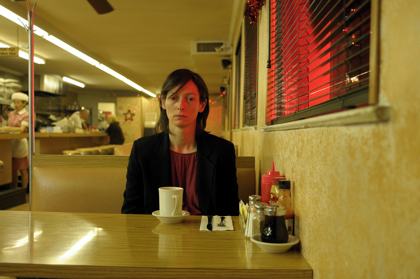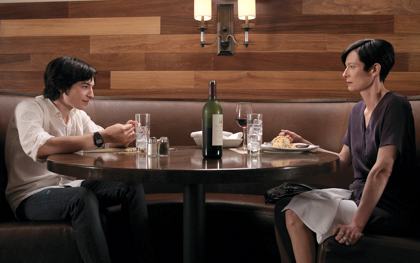Primary navigation


Lynne Ramsay’s long-awaited return to filmmaking expresses a mother’s nightmare of raising a hell-child through a splatter of flashbacks and teasing use of the colour red. Tim Robey is impressed
Lynne Ramsay’s first film since Morvern Callar (2002) might have been The Lovely Bones, which she read as an unfinished manuscript, had it not served up such a gloopy vision of the afterlife that blockbuster status was suddenly thrust upon it. (We all know how that panned out – “like My Little Pony”, in her own words.) Few such consolations are on offer in Lionel Shriver’s novel We Need to Talk About Kevin, even if it takes the form of epistolary therapy for its narrator, Eva Khatchadourian, after her son perpetrates a high-school massacre. The grim ironies of this format – specifically, what exoneration Eva means to gain from her husband Franklin, to whom her letters are addressed – only become clear at the novel’s finish, scuppering and practically mocking any hope of ‘closure’.
Ramsay and her writing partner Rory Kinnear (not to be confused with the British stage actor) forge ahead radically, stripping away the entire literary conceit without even the vestigial trace of voiceover. The film begins with the image of net curtains flapping in the night, and a helicopter-like swishing on the soundtrack which recurs almost tauntingly until we identify it as the work of a garden sprinkler-system. The curtains are a literal veil over the worst of what Kevin achieved, one day, with a crossbow, but the delayed reveal is one of the very few structuring decisions lifted straight from the book.
Ramsay’s film, particularly in its first third, is instead a jigsaw exercise in disassembly, suggestive of a catastrophe so explosive it has splintered time. We revisit Kevin’s conception, birth and traumatic (for his mother, more than him) upbringing, while also dropping in on him in prison, where he plays poker-faced games with Eva’s stunned questions. Note that it’s ‘we’, not ‘she’ – Ramsay’s formal choices, especially the implacable sound design and Seamus McGarvey’s at-a-remove cinematography, impose an eerie barrier between the ostensible storyteller and her guilt-inflected reminiscences, if you can even call them that. By doing this, the film trumps Shriver’s credulity-straining methods of recap, removing control so thoroughly from its main character that she can’t even marshal her own flashbacks – they happen to her out of the blue.

Or out of the red. It’s a colour filmmakers traditionally hold in reserve, banishing it from the frame except to link an ink spill with a dwarf’s overcoat. Ramsay applies lashings of the stuff, filling the screen with wasp-attracting jam splurges, or an extended reverie with Eva soaked and held aloft, in some halcyon days before pregnancy, at Valencia’s La Tomatina festival, or the linked Warholian image of her joylessly trapped against a supermarket wall of tomato soup cans. It’s an intentionally excessive motif that seems designed to bait critics, but works precisely as a kind of insult – it’s a colour that won’t leave Eva in peace. And Ramsay isn’t the only one at it: neighbours with a vendetta splash red paint all over Eva’s new house and car. The film has a high body-count, rushed trips to casualty, a sister’s eye lost to drainage cleaner, and you could easily come away with an impression of over-the-top grand guignol – except that only in the concluding sequence is a single drop of blood visible on screen.
As a prickly, leftist, brunette Armenian-American, Tilda Swinton isn’t, prima facie, ideal casting (in fact, you can well imagine an Egoyan version with the strident Arsinée Khanjian) but it’s hard to imagine a certain kind of effortful, teeth-gritting, fundamentally reluctant motherhood being nailed much better. Her rictus of faux-cheery striving with the screaming newborn Kevin sets up one of Ramsay’s most memorable sequences, which concludes with her hovering with the pram next to some ear-battering road works, filled with near-orgasmic relief at the baby-aggro being drowned out. From squalling infant to malevolent pipsqueak, the younger Kevins are terrific, but it’s Ezra Miller (Afterschool, City Island), with his saturnine sneer and mocking sexuality, who puts Swinton – an actress we tend to think of as in charge, especially when top-billed – excitingly through her paces.
For all Kevin’s atrocities, the most stinging moments here are the vituperations of the present-day timeline, where Eva calmly receives a savage slap in the face from a passing mother, or unprotestingly accepts 12 broken eggs at the checkout – another petty act of revenge – and goes home to pick shell out of her omelette as a kind of hair shirt. Underlining the character’s stoic use of self-blame as a coping mechanism – it’s the only rational explanation she can access for what took place – Ramsay’s unsettlingly calm film is really all about Eva. Significant sections of the book dealing with Kevin’s school career are prudently abandoned, keeping his sociopathic behaviour in a what-if realm. Any complaints about opaque psychology seem beside the point, as he’s meant to be nothing more nor less than the worst child imaginable – kryptonite to almost anyone’s mothering instincts.
Sexual relations: Geoff Andrew on a theme of intergenerational sex at Cannes (May 2011)
Afterschool reviewed by Lisa Mullen (September 2009)
Bloody Yorkshire: Nick James on the Red Riding trilogy (March 2009)
Flight of the Red Balloon reviewed by Kate Stables (April 2008)
Geometry of feelings: Guido Bonsaver on L’eclisse (July 2005)
Ratcatcher reviewed by Charlotte O’Sullivan (November 1999)
Felicia’s Journey reviewed by Jonathan Romney (October 1999)